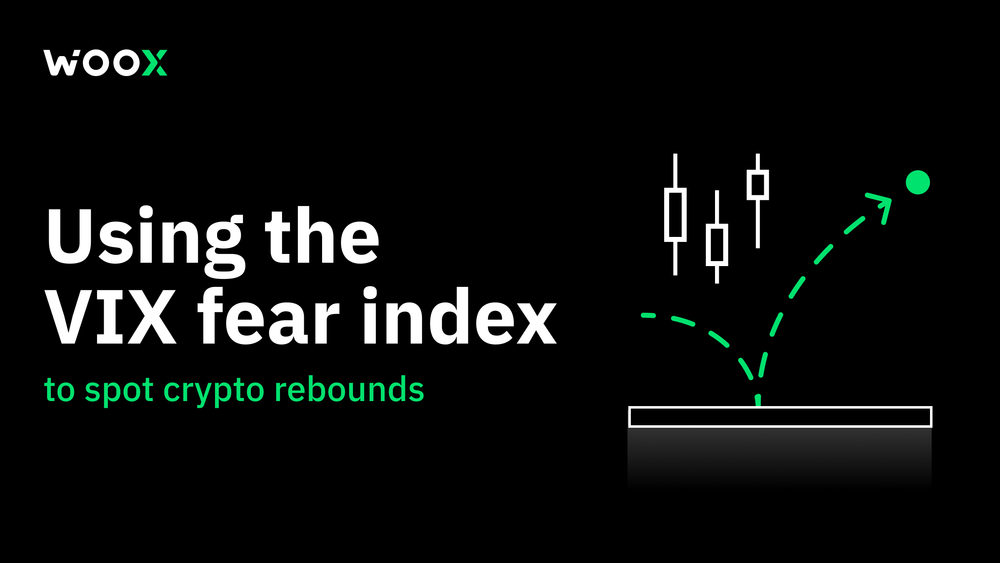How can the VIX fear index be used to time crypto markets?
By Pat Zhang, head of research at WOO X
The VIX, often called the “fear index,” reflects market expectations of near-term volatility based on S&P 500 options. The VIX functions as Wall Street’s sentiment barometer, often used by professional traders to gauge risk and anticipate turning points. While it’s a traditional equities tool, WOO X Research has found strong historical correlations between spikes in the VIX and rebound opportunities in cryptocurrencies, especially Bitcoin.
Background: Trade war escalation and a VIX surge to 60
In the beginning of 2025, the Trump administration escalated trade tensions by imposing a 10% tariff on nearly all imports and additional tariffs on countries with significant trade imbalances. This triggered a wave of global market panic, driven by:
- Increased operating costs and squeezed corporate profits
- Disrupted global supply chains
- Heightened geopolitical tensions and retaliation risks
In this context, investors typically:
- Rotate out of risk assets like equities and crypto
- Flock to safe-haven assets like gold, USD, and JPY
- Anticipate higher volatility → VIX spikes
On April 7, the VIX surged to 60, a level only reached three times historically, most notably during the COVID-19 crash in 2020. According to Zhang, this type of spike typically reflects peak uncertainty and investor fear, setting the stage for a possible market reversal and an opportunity that traders on WOO X may be watching closely.
What is the VIX?
The VIX is calculated using S&P 500 index options and represents the market’s forecast of 30-day volatility. A high VIX signals elevated fear and risk-aversion, while a low VIX suggests confidence and stability. Zhang notes that the VIX acts like a thermometer for market emotions — rising during shocks and falling as conditions stabilize.
Historically:
- 15–20 = calm
- 25+ = panic building
- 35+ = extreme fear
- 50+ = rare crisis-level stress
These levels help investors, including crypto traders on platforms like WOO X, determine when sentiment may be overly stretched and due for mean reversion.
High volatility panic zone: VIX ≥ 30
According to Zhang, when the VIX breaks above 30, it indicates intense market fear. While often accompanied by sharp selloffs, these moments historically signal short-term buying opportunities.
From 2018–2024, about a dozen VIX spikes above 30 led to:
- S&P 500: +1.4% average return in 7 days, ~73% win rate
- BTC: ~10% average return in 7 days, ~75–80% win rate
Events such as the February 2018 “volatility storm,” the 2020 pandemic, and the 2022 geopolitical crisis as key examples. In each case, markets saw a bounce once initial panic faded — a pattern WOO X Research continues to monitor closely for crypto traders.
Extreme panic peaks: VIX ≥ 40
When the VIX crosses 40, it enters extreme territory. Zhang points out that between 2018–2024, this level was only breached twice: during the 2018 volatility crash and the March 2020 COVID panic.
In both instances:
- S&P 500 saw modest rebounds (~+0.6% avg.)
- Bitcoin recovered strongly (~+7%), with win rates at 100%
In March 2020, the VIX hit 82 — its all-time high. While past sample sizes are limited, VIX ≥ 40 typically represents maximum capitulation, often marking the relative bottom of the cycle. Traders on WOO X, the crypto exchange, may interpret these signals as a time to accumulate risk assets before the broader market catches on.
Low volatility range: VIX ≤ 15
When the VIX drops below 15, it implies a calm market, with low hedging activity and optimistic sentiment. While equities may continue trending up during such periods, returns tend to be smaller and less reliable than during rebound setups.
From 2018–2024:
- S&P 500: ~+0.8% avg. 7-day return, ~60–75% win rate
- BTC: ~+2% avg. return, ~60% win rate
Bitcoin's correlation to the VIX is less predictable in these calm periods, sometimes rallying, dropping, making it less useful for timing crypto moves. Still, on-chain positioning data available through platforms like WOO X can help fill in the gap.
Summary table (condensed by WOO X Research)
Strategy takeaways
- VIX 30–40: This range signals heightened short-term risk, but Zhang views it as a potential reversal zone for equities and BTC. If the VIX peaks and retreats below 30, it may be a good time to look for entries, especially for traders using WOO X to rotate into high beta assets.
- VIX ≥ 40: Extreme fear often marks the end of capitulation. Zhang suggests these moments, though chaotic, are historically linked with high-probability short-term rebounds.
- VIX ≤ 15: Zhang cautions that market calm may mask complacency. A black swan event in such an environment could lead to a sharp and sudden repricing.
At the time of writing, the VIX hovers around 50, deep in panic territory. History could be a guide: in March 2020, the VIX hit 82 while the S&P 500 stood at 2300 points. Today, it’s nearly 5,000. Bitcoin, once at $4,800, reached $110,000 in the following bull cycle. These examples, compiled by WOO X Research, serve as reminders that despair often precedes opportunity.
Chaos acts as a ladder. Whether you climb it or get buried beneath it depends on preparation and perspective.
Disclaimer
The content above is neither a recommendation for investment and trading strategies nor does it constitute an investment offer, solicitation, or recommendation of any product or service. The information provided in this article is for general informational purposes only, does not constitute financial, investment, legal, or professional advice of any kind and does not bind WOO in any way.
Cryptocurrencies and similar instruments, including any products linked to such instruments, including without limitation leveraged or derivatives products thereof (“Products”), involve significant risk and are NOT suitable for the majority of investors. The value of such Products can be extremely volatile, and you should carefully consider your investment objectives, level of experience, and risk appetite before participating in any staking or investment activities in connection with such Products. We strongly recommend that you seek independent advice from a qualified professional before making any investment or financial decisions related to the Products. We shall in NO case be liable for any loss or damage arising directly or indirectly from the use of or reliance on the information contained in this content. By reading this content, you attest that you are fully aware that the trading of the Products may not be suitable for the general retail public and that you are an informed and qualified investor, and are also fully cognisant of all technological and financial risk(s) associated with trading such Products.
All market prices, data, and other information (including that which may be derived from third-party sources believed to be reliable) are not warranted as to completeness or accuracy and are subject to change without notice. We disclaim any responsibility or liability to the fullest extent permitted by applicable law, whether in contract, tort (including, without limitation, negligence), equity, or otherwise, for any loss or damage arising from any reliance on or the use of this material in any way. The information contained herein is as of the date and time referenced only, and we do not undertake any obligation to update such information.


